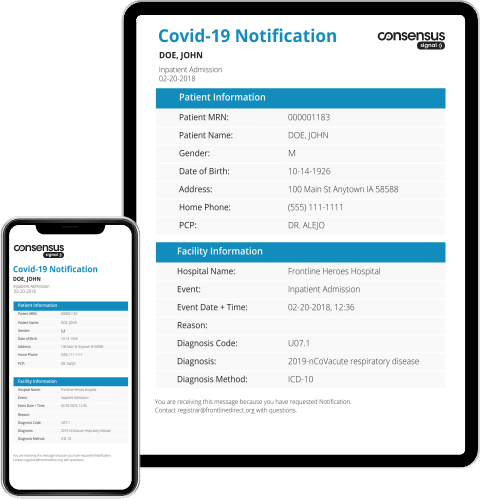Consensus Signal Can Do… What? Yep, Lower Your Costs for High-Need Members

ADT notifications represent a gold mine for payers
A recent meta-study by the Agency for Healthcare Research and Quality summarizes the issue well:
“Patients referred to as high-need, high-cost (HNHC) constitute a very small percentage of the patient population but account for a disproportionately high level of healthcare use and cost.”
One often-cited statistic says that for payer organizations like yours, just 5% of your highest-utilization members will be responsible for 50% (!) of your overall costs for healthcare services. In other words, even relatively small improvements in care management for your HNHC population can create significant cost savings for your company.
The good news is there’s a simple, cost-effective way to give your staff timely visibility into your HNHC members’ behavior, so they can take proactive steps to reduce hospital readmissions and other costly events. The answer is to automate Admission, Transfer, and Discharge (ADT) notifications when your members have an encounter with the healthcare system.
ADT alerts have gained traction throughout the industry due in large part to a 2021 Centers for Medicare & Medicaid (CMS) mandate that hospitals send these event notifications to patients’ primary care physicians, specialists, and other relevant medical providers.
But the compliance aspect of ADT notifications is only a small part of the story. For health plans and payer organizations like yours, the real significance of these timely alerts is that they can help you better care for your most vulnerable members — and lower your overall costs.
What the research says about the value of ADT alerts
According to a report published by the Journal of the American Medical Informatics Association, research has demonstrated ADT notifications’ clear benefits on member care, including:
- Reducing the likelihood of hospital readmission.
- Improving follow-up care after hospital discharge.
- Helping care coordinators identify and respond to previously unknown member events and utilization patterns.
How this can benefit your organization
Now let’s discuss how implementing a solution to receive electronic ADT alerts for your members’ healthcare events can benefit both member care and your bottom line.
Imagine one of your members, an elderly woman, calls 9-1-1 because she’s having trouble breathing. At the emergency department, a hospitalist administers oxygen. About 24 hours later, with her oxygen levels normalized, the physician sends the woman home with an order for a portable oxygen tank. Your company receives the claim for these services days or even weeks later.
Then, a week after that, the hospital sends you an almost identical claim. Your member suffered a second shortness-of-breath episode soon after the ED staff discharged her the first time.
Here are some of the ways a better workflow — specifically, if you were receiving electronic ADT event notifications on your members — could have improved this situation for your member’s health and your company’s bottom line.
Read the white paper:
How Event Notifications Help Payers Reduce Costs
1. Your care management team could have prepared to be proactive post-discharge.
Because your team often sees emergencies like this, particularly with elderly members, they would know that post-discharge compliance with the doctor’s guidance can make the difference in reducing the chances of readmission.
If the hospital had alerted you to this discharge immediately, your care management team could have taken proactive steps to ensure your member was complying with the oxygen treatment. They could have even begun remotely monitoring your member’s oxygen levels.
2. You could have made it easier for the hospital to uncover the underlying condition.
When a member is admitted to an ED or hospital, the payer will have a more longitudinal record of the member’s health history and can provide time-sensitive data quickly if the hospital sends the payer a real-time notification.
In this hypothetical, if the hospital had sent your organization an admission alert, and your team was able to quickly approve the relevant tests, you might have been able to help spare your member that second trip to the hospital and place her on a faster road to recovery.
3. You could have lowered your costs following the first episode.
Finally, there is a good chance you could have helped guide this process in a more constructive direction from the moment your member entered the hospital.
Your care management team, for example, could have gotten in touch with the member immediately and could have persuaded her about the importance of asking for post-discharge home-health check-ins, which could have saved your organization the costs of the readmission and follow-up treatment required.
Will Consensus Signal work for you?